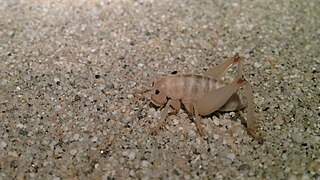
The orthopteran family Rhaphidophoridae of the suborder Ensifera has a worldwide distribution. Common names for these insects include cave crickets, camel crickets, Hogan bugs, spider crickets, land shrimp, and sand treaders. Those occurring in New Zealand are typically referred to as jumping or cave wētā. Most are found in forest environments or within caves, animal burrows, cellars, under stones, or in wood or similar environments. All species are flightless and nocturnal, usually with long antennae and legs. More than 500 species of Rhaphidophoridae are described.

Kelso Dunes, also known as the Kelso Dune Field, is the largest field of aeolian sand deposits in the Mojave Desert. The region is protected by the Mojave National Preserve and is located near the town of Baker, San Bernardino County, California, and the Preserve Visitor Center. The dune field covers 45 square miles (120 km2) and includes migrating dunes, vegetation-stabilized dunes, sand sheets, and sand ramps. The tallest dunes rise up to 650 feet (200 m) above the surrounding terrain.
Daihinibaenetes is a genus of sand-treader crickets in the family Rhaphidophoridae. There are at least three described species in Daihinibaenetes.

Macrobaenetes kelsoensis is a species of insect in family Rhaphidophoridae known commonly as the Kelso giant sand treader cricket. It is endemic to California, where it is known only from San Bernardino County.

Macrobaenetes is a genus of sand-treader crickets in the family Rhaphidophoridae, found in California. There are at least four described species in Macrobaenetes.

Macrobaenetes valgum, the Coachella giant sand treader cricket, is a species of insect in the family Rhaphidophoridae. It is endemic to the United States.

Utabaenetes is a genus of insects in the family Rhaphidophoridae. It is monotypic, containing the single species Utabaenetes tanneri, commonly known as Tanner's black camel cricket, that is endemic to the desert of San Rafael Swell in the western United States.

Gryllacrididae are a family of non-jumping insects in the suborder Ensifera occurring worldwide, known commonly as leaf-rolling crickets or raspy crickets. The family historically has been broadly defined to include what are presently several other families, such as Stenopelmatidae and Rhaphidophoridae, now considered separate. As presently defined, the family contains two subfamilies: Gryllacridinae and Hyperbaeninae. They are commonly wingless and nocturnal. In the daytime, most species rest in shelters made from folded leaves sewn with silk. Some species use silk to burrow in sand, earth or wood. Raspy crickets evolved the ability to produce silk independently from other insects, but their silk has many convergent features to silkworm silk, being made of long, repetitive proteins with an extended beta-sheet structure.
Daihinibaenetes giganteus, the giant sand-treader cricket, is a species of camel cricket in the family Rhaphidophoridae. It is found in North America.
Daihiniodes hastifera, the Arizona sand-treader cricket, is a species of camel cricket in the family Rhaphidophoridae. It is found in North America.
Daihiniodes is a genus of sand-treader crickets in the family Rhaphidophoridae. There are at least two described species in Daihiniodes.

Gammarotettix is a North American genus of camel crickets in the family Rhaphidophoridae. They are also called chaparral camel crickets or arboreal camel crickets and are between 10-18 mm. They live mainly in California and possibly in southern Oregon and Arizona.
Ammobaenetes arenicolus, the white sand-treader cricket, is a species of camel cricket in the family Rhaphidophoridae. It is found in North America.
Ammobaenetes is a genus of sand-treader crickets in the family Rhaphidophoridae. There are at least three described species in Ammobaenetes.
Daihiniodes larvale, known generally as the Stohecker's sand-treader cricket or Strohecker's camel cricket, is a species of camel cricket in the family Rhaphidophoridae. It is found in North America.
Ammobaenetes phrixocnemoides, known generally as the mesilla sand-treader cricket or Caudell's sand-treader cricket, is a species of camel cricket in the family Rhaphidophoridae. It is found in North America.
Daihiniella is a genus of sand-treader crickets in the family Rhaphidophoridae. There is one described species in Daihiniella, D. bellicosa.
Rhachocnemis is a genus of sand-treader crickets in the family Rhaphidophoridae. There is one described species in Rhachocnemis, R. validus.
Daihinibaenetes tanneri, the utah sand-treader cricket, is a species of camel cricket in the family Rhaphidophoridae. It is found in North America.
Ammobaenetes lariversi, the Nevada sand-treader cricket, is a species of camel cricket in the family Rhaphidophoridae. It is found in North America.








